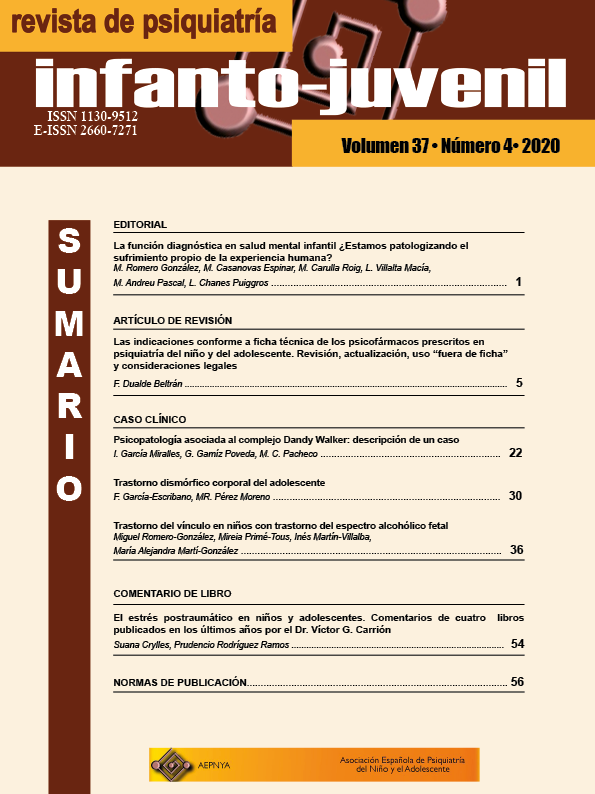Trastorno dismórfico corporal del adolescente
Publicado
Cómo citar
Número
Sección
Licencia
Derechos de autor 2020 Revista de Psiquiatría Infanto-Juvenil

Esta obra está bajo una licencia internacional Creative Commons Atribución-NoComercial-SinDerivadas 4.0.
DOI:
https://doi.org/10.31766/revpsij.v37n4a3Palabras clave:
Trastorno Dismórfico Corporal, adolescente, DSM-5, CIE-11, TOCResumen
El Trastorno Dismórfico Corporal (TDC) es un trastorno caracterizado por la preocupación por defectos físicos corporales no existentes, o apenas perceptibles, que generan un gran malestar psicológico o un deterioro en el funcionamiento de la persona que lo padece. La prevalencia de este trastorno oscila entre el 1,7 y 2,5% en la población general, siendo las dos terceras partes de los casos de inicio en la adolescencia. Existen diferencias significativas a la hora de clasificar este trastorno. Mientras que la CIE-10 lo hace dentro de los trastornos somatomorfos, el DSM-5 y la futura CIE-11 lo clasifican dentro del Trastorno obsesivo compulsivo (TOC) y Trastornos relacionados. Así mismo, a nivel clínico, pueden surgir dudas diagnósticas con los trastornos psicóticos o con los trastornos de la conducta alimentaria. Presentamos el caso de una paciente de 16 años, cuya sintomatología planteaba los interrogantes previamente descritos, decantándonos finalmente por el diagnóstico de TDC en la forma en que lo hacen el DSM-5 y la futura CIE-11 (TOC y trastorno relacionados), siendo tratada como tal y evolucionando de forma favorable. Este artículo tiene dos objetivos principales. En primer lugar, actualizar al lector en el novedoso cambio nosológico del TDC en la CIE-11, que se aproxima cada vez más a la orientación americana, siendo ésta la que hemos usado como referente para nuestro trabajo. En segundo lugar, profundizar en el diagnóstico diferencial de esta entidad, ya que no resulta una tarea sencilla y prueba de ello es el cambio clasificatorio anteriormente mencionado.
Descargas
Citas
American Psychiatric Association. Manual diagnóstico y estadístico de los trastornos mentales: DSM-5. Editorial médica Panamericana. 2014.
Salavert J, Clarabuch A, Trillo M. Trastorno Dismórfico Corporal: revisión sistemática de un trastorno propio de la adolescencia. Revista de psiquiatría infanto-juvenil 2019;36(1):4-19. https://doi.org/10.31766/revpsij.v36n1a1
Organización Mundial de la Salud. Guía de Bolsillo de la Clasificación CIE-10, Clasicación de los Trastornos Mentales y del Comportamiento. Madrid: Editorial Médica Panamericana. 2008.
Organización Mundial de la Salud. Clasificación de los Trastornos Mentales y del Comportamiento, 11ª revisión. Versión online. 2018.
Phillips KA. Pharmacotherapy for Body Dysmorphic Disorder. Psychiatr Ann 2010; 40(7):325-32. https://doi.org/10.3928/00485713-20100701-05
Harrison A, Fernández de la Cruz L, Enander J, Radua J, Mataix-cols D. Cognitive-behavioral therapy for body dysmorphic disorder: A systematic review and meta-analysis of randomized controlled trials. Clin Psychol Rev. 2016;48:43-51. https://doi.org/10.1016/j.cpr.2016.05.007
Phillips KA, Didie ER, Menard W, Pagano ME, Fay C, Weisberg RB. Clinical features of body dysmorphic disorder in adolescents and adults. Psychiatry Res. 2006;141(3):305-14. https://doi.org/10.1016/j.psychres.2005.09.014
Atmaca M, Bingol I, Aydin A, Yildirim H, Okur I, Yildirim MA et al. Brain morphology of patients with body dysmorphic disorder. J Affect Disord. 2010;123(1-3):258-63. https://doi.org/10.1016/j.jad.2009.08.012
Phillips KA, Zai G, King NA, Menard W, Kennedy JL, Richter MA. A preliminary candidate gene study in body dysmorphic disorder. J Obsessive Compuls Relat Disord. 2015;6:72-6. https://doi.org/10.1016/j.jocrd.2015.06.004
Phillips KA. Body dysmorphic disorder: Assessment, diagnosis, and differential diagnosis. Uptodate 2018.









 © 2021 AEPNyA Todos los derechos reservados
© 2021 AEPNyA Todos los derechos reservados
